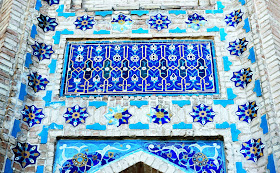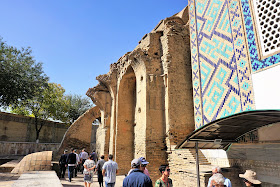By the time we got to the Gur-e-Amir, which is Persian for "Tomb of the King" (and which is also known as the Amir Timur Mausoleum), we had seen dozens of gasp-inducing, mind-bending, pinch-me-am-I-really-seeing-this edifices. You'd think we would have been jaded after all we had already seen. Judging by the number of photos I have of this Mausoleum, however, I still had room for a little more awe.
Some of this architecture was, by this time in the trip, very familiar--the huge vertical slabs used as portals to courtyards, the wide towers topped by azure domes, the unbelievably intricate details--but this mausoleum of the most powerful conqueror of Middle Asia was truly over the top, adding even more design features and ostentatious bling to architecture that I had thought could not be made any more elegant.
Here are two better views. Absolutely stunning.
Here is a better look of that vertical panel that frames the portal. Even a close-up shot can't really capture how magnificent this is. Let me remind you that we are talking TILES, not paint.
Look through the arched portal and what do you see? Not just the standard tiled dome, but one with rounded ribs covered in patterned tiles, massive in size but somehow as delicate as sheer curtain pleats. This mausoleum is believed to be the precursor and model for the Taj Mahal in India, which is similarly both immense and dainty.

We walked through that door to get a closer look:
The view of the dome from another angle shows two pillars that look a bit like smokestacks:
They are taller and more majestic than they seem in the picture above:
This is a semi-micro view of the macro view above:
There are beautiful surprises everywhere:
Who was the man for whom this mausoleum was built?
In short, he was the conqueror and then dictator of the land mass that now includes The Stans, Iran, Iraq, Syria, Kuwait, Afghanistan, Pakistan, Turkey, and parts of China, India, and Russia.
He was someone you would have wanted as a friend because you definitely wouldn't have wanted him as an enemy. You can read more about him at the end of this earlier post.
Yeah, he could pretty much have whatever he wanted, and he wanted this mausoleum as a place to bury a beloved grandson who died at a young age. However, Timur himself died in 1405 before the mausoleum could be completed. No worries, Timur's grandson Ulugh Beg (see a post about him here) completed the mausoleum--and was eventually buried here as well.
Timur lies directly under that dark green box in the center. It is made of a single piece of jade that is believed to be the biggest piece of jade in the world. The other tombs, all made of marble, mark the bodies of two of Timur's sons, two of his grandsons (including Ulugh Beg), and Timur's favorite teacher:

Outside the mausoleum but inside the courtyard is an entrance to the crypt. We were able to go down the steps, which were very steep, but we couldn't really see anything:
Two days later, Nazi Germany invaded Russia, and many of the locals saw a cause-and-effect relationship between the desecration of Timur's tomb and the German invasion and subsequent suffering. Coincidentally, a month after Stalin ordered that Timur's remains be returned to Samarkand and given a full Islamic burial, Russia won the Battle of Stalingrad, which marked a turning point in the war.
Incidentally, the scientists did confirm that Timur was lame and had a withered right arm due to injuries, confirming the stories that had been told about him for centuries.
. . . and this grandma got to take a turn too!







































Your photos looking up at the muqarnas are stunning. Probably my favorite of the trip so far. I'd forgotten that they actually exhumed the body. Was it possible to go down the stairs into the crypt? Samarkand is a wonder.
ReplyDeleteYes, we went down, but there wasn't much to see.
DeleteSo the muqarnas that we saw in Spain--stripped of color--could have been more like your lacey white ones? All this time I kept thinking that they needed to restore them, but the possibilities that they were a different color is definitely there. Fascinating post--love the photos at the end!
ReplyDeleteThank you for the excellent photo guide to tourist Uzbekistan! Very beautiful architecture, the shades of blue are simply stunning!
ReplyDelete